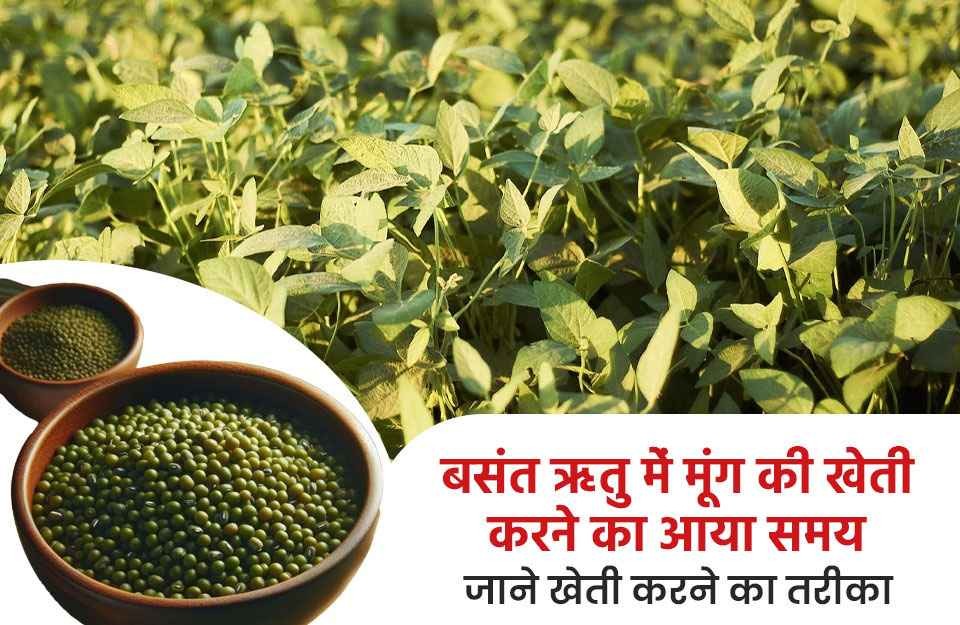
The moong crop is cultivated during the summer and monsoon seasons and belongs to the category of pulse crops. It is a rich source of protein, carbohydrates, and fats. The roots of moong plants contain nodules that fix atmospheric nitrogen in the soil, contributing 1.5 tons of organic matter per hectare in the form of roots and leaves during harvest time, thereby enhancing soil fertility.
Madhya Pradesh, moong cultivation is predominantly carried out in districts like Jabalpur, Gwalior, Harda, Bhind, Shivpuri, Morena, and Shyopur. Adoption of advanced varieties and modern agricultural practices can further boost production. Moong beans are commonly used for preparing lentils. However, the average productivity in Madhya Pradesh stands at approximately 350 kilograms per hectare, which is relatively low.
Maintain a row-to-row distance of 30 to 40 cm for moong cultivation. Seeds should be sown at a depth of 5 to 6 cm. Ensure proper depth during sowing. Moong seeds should be sown only after treating them with carbendazim. After plowing the soil, cultivate it once using a cultivator when the rains commence, and then level the field by harrowing without forming clods. For moong cultivation during the summer season, after harvesting the Rabi crops, the field should be plowed immediately and left for 4-5 days before leveling it with a harrow or cultivator equipped with ridges. This helps retain moisture in the soil, facilitating optimal seed germination.
Moong cultivation is best suited to areas with access to irrigation, preferably following the harvest of Rabi crops. During the monsoon season, moong cultivation should occur from the second to the third weeks of June until mid-July. Delaying cultivation can lead to decreased fruit formation due to higher temperatures during flowering, resulting in lower yields.
Moong thrives in regions with warm and humid climates, typically grown during the rainy season. An optimal temperature range of 25-35 degrees Celsius fosters its growth. Areas receiving an annual rainfall of 80-90 cm are ideal for moong cultivation. During the ripening stage, clear weather and 60% humidity are beneficial. Both irrigated and rainfed areas are suitable for cultivation. Well-drained sandy loam soil with efficient water drainage is preferred for moong cultivation, with an ideal soil pH value ranging between 7.0 and 7.5.
Irrigation and Drainage Management: During the rainy season, moong crops require minimal irrigation. However, if there is a prolonged gap between rainfall events or reduced moisture levels during fruit formation, light irrigation becomes necessary. Irrigation should be conducted every 10-15 days during the summer and spring seasons. Irrigation should cease 15 days prior to moong maturation. In the event of excessive rainfall or waterlogging in the field, proper drainage measures should be implemented to prevent water accumulation.
Improved Moong Varieties: Some of the improved varieties of moong include Narendra Moong 1, Jawahar Moong 45, Pant Moong 2, HUM 6, Sunaina, També Jawahar Moong-3, PDM – 11, Pusa Vishal, KE-851, and others.
Seed Quantity: During the hot season, it is recommended to sow 20 kilograms of moong seeds per hectare, with rows spaced 20-25 cm apart. In the monsoon season, the seeding rate should be 12 to 15 kilograms per hectare, with rows spaced 30 to 40 cm apart.
Read More : Chilli Cultivation Variety Disease and Management Know Complete information
Fertilizers and Nutrients: Moong, being a pulse crop, requires 20 kilograms of nitrogen, 50 kilograms of phosphorus, and 20 kilograms of potassium per hectare during sowing. In areas with sulfur deficiency, sulfur-containing fertilizers should be applied at a rate of 20 kilograms per hectare.
Weed Management and Inter-Cultivation: During the monsoon season, common weed species in moong crops include Dub, Grass, and broad-leaved weeds like Patthar Chatta Mahkua, Hazar Dana, Mahkua, Safed Murg, Lahsua, and Motha. Weeds typically persist in moong fields for 25-30 days. Weeding and inter-cultivation should be carried out at intervals of 15-20 days, with secondary plowing done at intervals of 35-40 days. Chemical eradication of grass and broad-leaved weeds can be achieved by using 1.5 liters of Fluchloralin 45 EC per hectare mixed with 800-1000 liters of water, applied to the field before sowing.
Moong Pest Management: